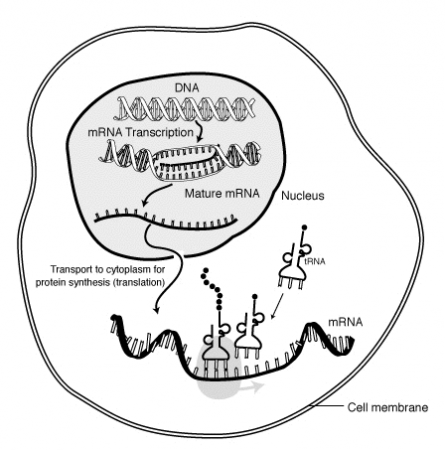From PBS’s DNA The Secret of Life.
Category: Biology
The Digestive System
In his critique of research on the beneficial-bacteria storing role of the appendix, PZ Myers includes an excellent overview of the digestive system.
When you eat something, it first goes into the stomach, where it’s treated to an acid bath, some enzymes, and a lot of muscular churning to break it up. Then it’s squirted into the small intestine, where the acids are first neutralized and more enzymes are tossed onto the watery, mushy soup that the food has been rendered down into, called chyme. The primary job of the small intestine is to suck all the nutrients out of the chyme and pass them on to the circulatory system.
Once as much of the good stuff has been leeched out of the chyme as your system can do, the soup is passed on to the large intestine …. This stuff is still very watery — if you’ve ever experienced diarrhea, that’s what it is at this point. The primary job of the large intestine is to resorb water from the waste, condensing it down into the thick, pasty glop we all know and love as excrement. The large intestine is basically the sewage treatment plant here.
— Meyers, 2009: Evolution of the appendix? in ScienceBlogs.
“Junk” DNA: Not so much
It has always strained credibility that the 98% of our DNA not used to code proteins would be useless. But this non-coding DNA picked up the name “junk DNA” because no-one quite knew what it did. In fact, one study (Nóbrega, 2004) found that deleting large chunks of DNA had no discernible effect on mice; the mice born without these pieces of non-coding DNA were viable.
However, a slew of papers from the Encode project indicate that the part of our genome formerly known as junk DNA, regulates the 2% that does the protein coding:
The researchers … have identified more than 10,000 new “genes” that code for components that control how the more familiar protein-coding genes work. Up to 18% of our DNA sequence is involved in regulating the less than 2% of the DNA that codes for proteins. In total, Encode scientists say, about 80% of the DNA sequence can be assigned some sort of biochemical function.
— Jha (2012): Breakthrough study overturns theory of ‘junk DNA’ in genome in The Guardian.
This is more good news for useless bits of biology (see the appendix).

The Appendix: A Useless bit of Biology? Perhaps Not
The appendix has long been supposed to be a vestigial, useless organ. But a 2007 study suggests that it might have had — and may still have in many developing countries — an important role in digestion. It may provide a refuge for helpful, commensal bacteria to repopulate our guts after we purge when we get sick (Bollinger et al., 2007):

… the human appendix is well suited as a “safe house” for commensal bacteria, providing support for bacterial growth and potentially facilitating re-inoculation of the colon in the event that the contents of the intestinal tract are purged following exposure to a pathogen.
— Bollinger et al., 2007: Biofilms in the large bowel suggest an apparent function of the human vermiform appendix in the Journal of Theoretical Biology.
Why do they think that? What’s the evidence?
The shape of the appendix is perfectly suited as a sanctuary for bacteria: Its narrow opening prevents an influx of the intestinal contents, and it’s situated inaccessibly outside the main flow of the fecal stream.
–Glausiusz (2008): And Here’s Why You Have an Appendix in Discover Magazine.
And thinking about supposedly useless bits of biology, there’s a bunch of interesting papers coming out about so-called “junk” DNA.
Exponential Growth/Decay Models (Summary)
A quick summary (more details here):
The equation that describes exponential growth is:
Exponential Growth: ![]()
where:
- N = number of cells (or concentration of biomass);
- N0 = the starting number of cells;
- r = the rate constant, which determines how fast growth occurs; and
- t = time.
You can set the r value, but that’s a bit abstract so often these models will use the doubling time – the time it takes for the population (the number of cells, or whatever, to double). The doubling time (td) can be calculated from the equation above by:
![]()
or if you know the doubling time you can find r using:
![]()
Finally, note that the only difference between a growth model and a decay model is the sign on the exponent:
Exponential Decay: ![]()
Decay models have a half-life — the time it takes for half the population to die or change into something else.
Live Bears
Watch brown bears catch salmon in Katmai National Park on a live webcam:
Every year over a hundred Brown Bears descend on a mile long stretch of Brooks River to feast on the largest Sockeye Salmon run in the world.
— bears: brown bear & salmon cam – brooks falls on explore.org

ZygoteBody: Human Anatomy in 3D
With a simple, but effective interface, ZygoteBODY’s free, online 3d models of human anatomy are excellent.

Anatronica: 3d Anatomy Online

Anatronica has an excellent, online, 3d viewer for the anatomy of the human torso. While it’s not quite the same as a physical model, it’s pretty good as a study guide for middle schoolers.